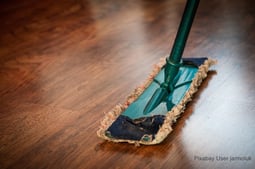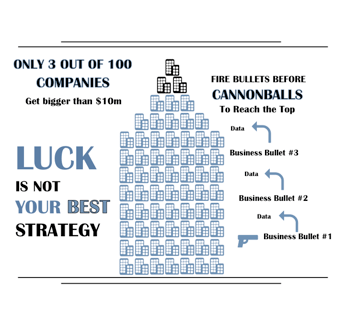I owned a company while in my late twenties that wasn’t glamorous but it was profitable - a commercial cleaning business. This was the one time, the one business where I got lucky and reached a poorly defined BHAG.
cleaning business. This was the one time, the one business where I got lucky and reached a poorly defined BHAG.
I determined that my BHAG was to grow a business large enough to sell through a broker. There was no inspiration, just the dream that a broker would find someone to buy it. This was a type of financial BHAG, and now, an approach I don’t recommend because luck is not your best strategy and without inspiration doesn't engage the energy of your team.
It’s OK to want to be a $275 million company, but as a BHAG it doesn’t help direct what your team should say “yes” to, or what they should say “no” to – and that leaves you doing all the heavy lifting because your team has no inspiration and no real focus.
Jim Collins said that many companies die before they can become great because of too many opportunities. At Rhythm Systems we call it “overeating from the buffet of opportunity.” When your BHAG is revenue (or a broker selling your business), everything becomes fair game to chase a dollar - and often, while chasing dollars, we miss a real opportunity.
Instead, create a BHAG that is more descriptive of destination versus a financial number. An example used recently in our webinar Executing Toward Your BHAG was when John F. Kennedy came up with the national BHAG of “send a man to the moon and bring him back by the end of the decade.” This destination BHAG was inspiring and therefore created many other national opportunities and innovations that are now everyday items. Innovations from that one BHAG include the memory foam in my favorite pillow, my smoke detector, and my water filter.
Let me describe some of my luck that will help you outline successful growth once your inspirational BHAG is in place. To clean carpets in large county and city buildings we used truck mount carpet-cleaning equipment. This equipment sat idle during the day, and we brainstormed potential Winning Moves to use it for revenue generation during the day. One idea surfaced and loaded...
BHAG is in place. To clean carpets in large county and city buildings we used truck mount carpet-cleaning equipment. This equipment sat idle during the day, and we brainstormed potential Winning Moves to use it for revenue generation during the day. One idea surfaced and loaded...
Business bullet #1: Dedicate one salesperson to sell carpet cleaning to apartment communities and other rental property owners. But the data indicated this was a wrong move - that selling only carpet cleaning put us in a price war. I wasn’t interested.
After continued brainstorming, we felt our Winning Move must be to sell a complete package of cleaning, painting, and carpet cleaning for empty rental units to the same prospects. On page 44 of the book Rhythm, our CEO Patrick Thean asks, “What is your competition not willing to do that your core customers need?” I made the assumption that I could save property owners money and more importantly - solve their big problem of turnover speed for empty rental units. Faster turns meant faster rental, and that meant cash. It was time to test my assumption.
So I fired business bullet #2: I traveled to Atlanta, GA, to investigate a company already doing this and after two days of investigation, returned home ready to implement. Basecamp envisioned. It was time to fire the next bullet.
Business bullet #3: I taught one sales person how to present our new service. We experienced multiple failures from this effort and used the data to further adjust. We had more failures and made more adjustments. The data finally indicated we were on the right track, and I immediately trained the remainder of our sales team. In four months, we were winning 60% of proposals presented. Basecamp established. This one Winning Move doubled revenue in 18 months.
By then, we faced our next challenge. Commercial building owners wanted dry cleaning methods for carpets - mostly due to the risk of slips, trips, and falls as people stepped from damp carpets onto tile. Now, our carpet trucks sat idle at night. As our competitors fought this trend and attempted to “stay the course,” we began brainstorming our next Winning Move. We believed our competitors were unwilling to serve areas outside a 25-mile radius and that was our focus.
So we tested our assumption with another business bullet: I redirected one telephone salesperson to call on area directors of carpeted multi-unit retail or restaurant operations. The initial data came back positive - regional managers wanted one vendor, one call, one responsibility rather than 10-25 vendors due to geographic restriction. We loaded our cannons and went all in after this business. Two years of 90-100% growth took us from Florida to Maine and west to the Mississippi. With national and regional contracts including Pizza Huts, Blockbuster Video, Applebee’s, Quincy’s Steak House, and mall-based clothing stores, I got lucky and sold the business.
This was a happy ending, but trusting luck is the worst BHAG advice you’ll ever get.
Instead, follow the step-by-step advice in our BHAG Guide, read Chapter 2 and 3 of the book Rhythm, and you’ll have the blueprint to BHAG success – no luck required.
Photo Credit: iStock by Getty Images



 LinkedIn
LinkedIn
 Facebook
Facebook
